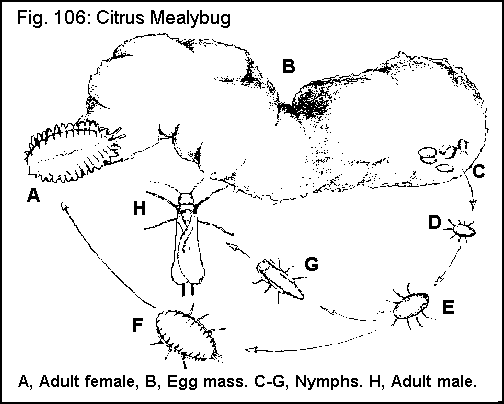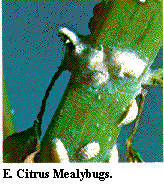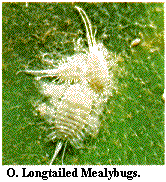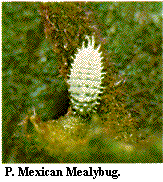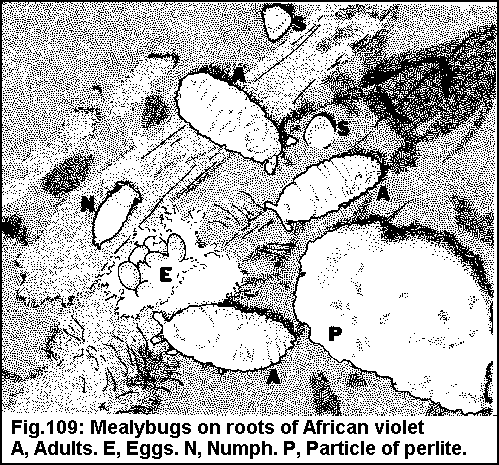Introduction
One of the more common groups of scale insects attacking ornamental plants are called mealybugs. There are about 275 species of mealybugs known to occur in the continental United States. Mealybugs are prevalent pests in greenhouses and interior plantscapes such as shopping malls, conservatories, hotels, and office buildings. Mealybugs cost growers and retailers millions of dollars per year in control costs and crop damage or loss. Damage is caused by mealybugs feeding on host tissues and injecting toxins or plant pathogens into host plants. In addition, mealybugs secrete a waste product, honeydew, which is a syrupy, sugary liquid that falls on the leaves, coating them with a shiny, sticky film. Honeydew serves as a medium for the growth of sooty mold fungus that reduces the plant's photosynthetic abilities and ruins the plant's appearance. Feeding by mealybugs can cause premature leaf drop, dieback, and may even kill plants if left unchecked.
Mealybugs are one of the more active groups of scale insects as most of them retain well-developed legs and remain mobile throughout their life. However, they generally move little once a suitable feeding site is found. They are small insects (1 to 4 mm long) and the body is usually covered with a white cottony or mealy wax secretion. This makes them appear like small spots of cotton on the plant, particularly when the female is laying eggs and producing an ovisac to cover and protect the eggs. Mealybugs generally have an oval body outline. Many of them produce marginal filaments of wax that may be wedge-shaped or spinelike, but others lack marginal filaments entirely. As immatures, male and female mealybugs look alike, but as adults they are quite different. The adult male looks more like a small two-winged fly.
The life history of mealybugs varies depending on the species. Basically female mealybugs go through four developmental stages or instars and as adults may lay up to 600 eggs, usually in a cottony-like ovisac beneath her body. The eggs hatch in 6 to 14 days and the first instars or "crawlers," as they are commonly called disperse to suitable feeding sites on new plant parts or hosts. They can survive only about a day without feeding, and once they insert their stylets to feed they generally remain anchored permanently. The crawler stage is the most fragile and easily controlled stage in a mealybug's life history. Some mealybugs, like the longtailed mealybug, do not lay eggs, but bear their young as active crawlers. Male mealybugs go through five instars and feed only in the first two instars. Adult males have no functional mouthparts, live only a day or two, and exist solely to fertilize the females.
Outdoors most mealybugs go through one or two synchronized generations and overwinter as second instars. Indoors, there may be a continuous overlapping of generations and all stages can be found on the host at a given time. The citrus mealybug may have as many as eight generations indoors. The overlapping of generations makes control difficult. One of the first methods of control is to purchase plants that are not infested with mealybugs. Commercial flower growers sometimes discard plants infested with mealybugs rather than try to rescue them with insecticidal treatments.
Common mealybugs occurring indoors include: the citrus mealybug, the longtailed mealybug, the Mexican mealybug, and Pritchard's ground mealybug. Citrus mealybug is by far the most common and widespread mealybug pest. It attacks nearly every flowering species grown in the greenhouse.
Key to the Most Common Mealybugs Found on Flowers and Foliage
- Adult females with long, white filaments at the rear (Figure 104A); females apparently giving birth to live young - LONGTAILED MEALYBUG
Adult females without long, white filament at the rear; females lay eggs in a dense, white fluffy ovisac - GO TO 2 - Female feeding on above ground portion of plant - GO TO 3
Female never feeding on above ground portions of plant; white mealybug feeding on roots (Figure 104B) - PRITCHARD'S MEALYBUG AND OTHER ROOT MEALYBUGS - Body orangish or purplish and covered with white bloom; a darker line down the middle of the back (Figure 105A); mealybug very damaging to the health of many plants - CITRUS MEALYBUG
Body purplish and covered with white bloom; three rows of white tufts down the back (Figure 105B); may occur in high numbers with little effect on the health of the plant - MEXICAN MEALYBUG
Citrus Mealybug
Citrus mealybug (Figure 106), Planococcus citri (Risso), Pseudococcidae, HOMOPTERA
DESCRIPTION
Adult
The female citrus mealybug is wingless and appears to have been rolled in flour (hence the name). It grows to 3 mm long and 1.5 mm wide. A fringe of small waxy filaments protrude from the periphery (Figure E). The male is small, but with its wings and tail filaments, it appears to be 4.5 mm long.
Egg
The oblong, yellow eggs are enmeshed in a dense, fluffy, white ovisac.
Crawler
The tiny crawler is oval and yellow, with red eyes. The antennae are rather distinct.
Nymph
Female nymphs resemble the larger adult females. Male nymphs are narrower and often occur in a loose cocoon.
BIOLOGY
Distribution
Citrus mealybugs occur in southern Europe and in the southern United States, where they overwinter outdoors. Further north, they survive in greenhouses and homes.
Host Plants
Citrus mealybugs have been collected from at least 27 host plant families. Many ornamental plants grown in greenhouses are susceptible to attack including begonia, coleus, amaryllis, cyclamen, and dahlia. Citrus mealybug has been collected on canna, narcissus, and tulip outdoors.
Damage
Vitrus mealybugs damage hosts by sucking out plant sap, by excreting honeydew in which sooty mold can grow, and by causing distorted growth and premature leaf drop with their toxic saliva. They further disfigure plants by secreting cottony wax. Infested plants usually die unless the pest is controlled.
Life History
The citrus mealybug has been recognized as a pest of citrus and ornamental plants in Europe since 1813 (where it is called the greenhouse mealybug) and in the United States since 1879. Because female citrus mealybugs have no wings, they must be transported to the proximity of the next host plant. They can, however, travel short distances by crawling and the immatures can be blown about. Males are small, winged insects. After mating, each female lays up to hundreds of eggs in a dense, fluffy secretion called the egg sac or ovisac. Within a few days, new mealybugs (crawlers) hatch and begin to squirm out of the ovisac. Light infestations are easily overlooked because the mealybugs tend to wedge into crevices on the host plant. As their numbers increase, mealybugs of all sizes can be seen crawling around or feeding on all exposed plant surfaces.
CONTROL
Control of citrus mealybugs is amazingly difficult. Some commercial flower growers merely discard infested plants rather than trying to rescue them from citrus mealybugs. Horticultural oils may damage amaryllis. For specific chemical controls, consult the current Cooperative Extension publications on ornamental plant pest management or consult your county Extension agent.
Longtailed Mealybug
Longtailed mealybug (Figure 107), Pseudococcus iongispinus (Targioni-Tozzetti), Pseudococcidae, HOMOPTERA
DESCRIPTION
Adult Female
Up to 3 mm long, female longtailed mealybugs have 17 pairs of waxy filaments around the periphery. On mature specimens, the caudal (tail) filaments are as long as or longer than the yellowish to grayish body (unless the tail filaments have broken off) (Figure O). Overall length maybe 6 to 7 mm.
Egg
There is no external egg stage of the longtailed mealybug.
Nymphs
The nymph is similar to the larger adult female except that the filaments around the edges are shorter.
BIOLOGY
Distribution
Longtailed mealybugs appear to be cosmopolitan in tropical and subtropical environments. In temperate zones, they survive in greenhouses or homes throughout the world.
Host Plants
Longtailed mealybugs have been found on at least 26 plant families. Dracaena appears to be the favored host, but most flowering and ornamental foliage plants are susceptible.
Damage
Longtailed mealybugs feed by sucking out plant sap from leaves and stems. Honeydew and sooty mold further disfigure infested plants, which may eventually be killed. These pests also secrete a fluffy white wax which also detracts from the appearance of infested plants.
Life History
Although longtailed mealybugs were first described in 1867, not much has been published on their biology. Females give birth to live young on a shallow pile of white waxy secretions. Because the females are wingless, they must be brought into proximity of a host plant before it can be infested. A small wasp, Anagyrus nigricornis, parasitizes longtailed mealybugs, and a small, predaceous, brown lacewing insect feeds on them. Ants sometimes protect longtailed mealybugs from parasites and predators and feed upon the honeydew excreted by these mealybugs.
CONTROL
Brown and green lacewings exert some biological control of these mealybugs. Longtailed mealybugs are sometimes difficult to control, even though there is no egg stage protected by a dense ovisac. If many plants are infested, they should be dipped or sprayed thoroughly with a pesticide mixture or the entire greenhouse treated with an aerosol. It is best to retreat two or more times at weekly intervals. Retreatment will control mealybugs that were missed by earlier control efforts. For specific chemical control recommendations, see the current Cooperative Extension publications on ornamental plant pest management or consult your county Extension agent.
Mexican Mealybug
Mexican mealybug (Figure 108), Phenacoccus gossypii Townsend and Cockerell, Pseudococcidae, HOMOPTERA
DESCRIPTION
Adult
The female Mexican mealybug adult is 3 to 4 mm long, oval, grayish and covered with a thin waxy secretion. There are three parallel rows of small waxy tufts down the back (Figure P). This insect is a short-tailed mealybug (the caudal filaments do not exceed 1⁄4 the body length). The lateral filaments are also short. Males are small gnatlike insects with only two wings. Adult Mexican mealybug males have four waxy, posterior filaments.
Eggs
The egg sac is white, dense, narrow, and longer than the female secreting it.
Nymphs
The nymphs are small and yellowish with white waxy secretions.
BIOLOGY
Distribution
From Mexico the mealybug has spread throughout the United States, Hawaii, Cuba, and Puerto Rico. It survives in greenhouses and on houseplants in temperate climates and outdoors in subtropical areas of the United States.
Host Plants
The Mexican mealybug is found commonly on numerous ornamental plants, a few of which are aralia, chrysanthemum, English ivy, geranium, Gynura, hollyhock, Ixia, lantana, and poinsettia. This insect is also a minor pest of lima beans in the warmer parts of the United States.
Damage
Wilting and stunting are common symptoms of Mexican mealybug attack. This insect can be as damaging as the citrus mealybug. The mealybugs and ovisacs also disfigure heavily infested plants.
Life History
In the greenhouse, the Mexican mealybug may have seven complete generations in one year. The average time required from oviposition to the adult stage is 47 days. Each female deposits about 400 eggs. The eggs are enclosed in an elongate cottony mass called the ovisac that originates at the back of the female. The ovisac is about 6 mm long. The eggs hatch in 6 to 14 days. The life cycles of the male and female Mexican mealybugs differ. A female passes through three nymphal stages only. Male Mexican mealybugs pass through two nymphal stages and two resting stages (prepupal and pupal stages). Normally, these mealybugs are found above ground on the leaves, stems or flowers, but occasionally will be found feeding on the roots.
CONTROL
For chemical control recommendations, see the current Cooperative Extension publications on ornamental plant pest management or consult your county Extension agent.
Root Mealybug
Root mealybugs (ground mealybug) (Figure 109), Rhizoecus falcifer Kunckel d'Herculais, Pseudococcidae, HOMOPTERA
Pritchard's mealybug, Rhizoecus pritchardi McKenzie and Rhizoecus americanus (Hambleton), Pseudococcidae, HOMOPTERA
DESCRIPTION
Adult Female
The ground mealybug is white and 2.4 to 3.9 mm long. It resembles a springtail, but moves much more slowly and cannot jump. The ground mealybug has slender waxy filaments that form a sort of netting over some individuals. The ground mealybug also secretes a small amount of wax, which can give the soil a somewhat bluish appearance when the mealybugs are abundant. Pritchard's mealybug is snow white and 1.6 to 2.1 mm long and oval. It has small- to non-existent eyes.
BIOLOGY
Distribution
The ground mealybug was described in France and occurs in scattered locations across the United States. Pritchard's mealybug is found across the United States.
Host Plants
The ground mealybug feeds on the roots of anemone, chrysanthemum, gladiolus, iris, and numerous other flowers, shrubs, and ornamental grasses. Pritchard's mealybug has become a serious pest of African violet, although it also infests Achillea, Arctostaphylos, Geum, and Polygala.
Damage
At times the ground mealybug becomes abundant enough to damage its host. Pritchard's mealybug causes devitalization, foliage deterioration, and even death of its host plant.
Life History
Little has been published on the life history of root mealybugs. When infested African violets are irrigated, Pritchard's mealybugs crawl out of the drainage holes and spread throughout the greenhouse. Eggs are laid in a loose ovisac in clusters of at least six eggs. All stages can be found on the roots and potting mix of African violets where they resemble slow moving, snowy white collembola.
CONTROL
Pesticides applied as dips, drenches, or granulars are more effective for root mealybug control than are foliar sprays. For specific chemical control recommendations, see the current Cooperative Extension publications on ornamental plant pest management or consult your county Extension agent.
Publication date: Jan. 1, 1994
AG-136
Other Publications in Insect and Related Pests of Flowers and Foliage Plants
- Aphids Found on Flowers and Foliage
- Beetles Found on Flowers and Foliage
- Bugs Found on Flowers and Foliage
- Caterpillars Found on Flowers and Foliage
- Flies and Maggots Found on Flowers and Foliage
- Leafhoppers Found on Flowers and Foliage
- Mealybugs Found on Flowers and Foliage
- Mites Found on Flowers and Foliage
- Scale Insects Found on Flowers and Foliage
- Slugs and Snails Found on Flowers and Foliage
- Thrips Found on Flowers and Foliage
- Whiteflies Found on Flowers and Foliage
N.C. Cooperative Extension prohibits discrimination and harassment regardless of age, color, disability, family and marital status, gender identity, national origin, political beliefs, race, religion, sex (including pregnancy), sexual orientation and veteran status.



